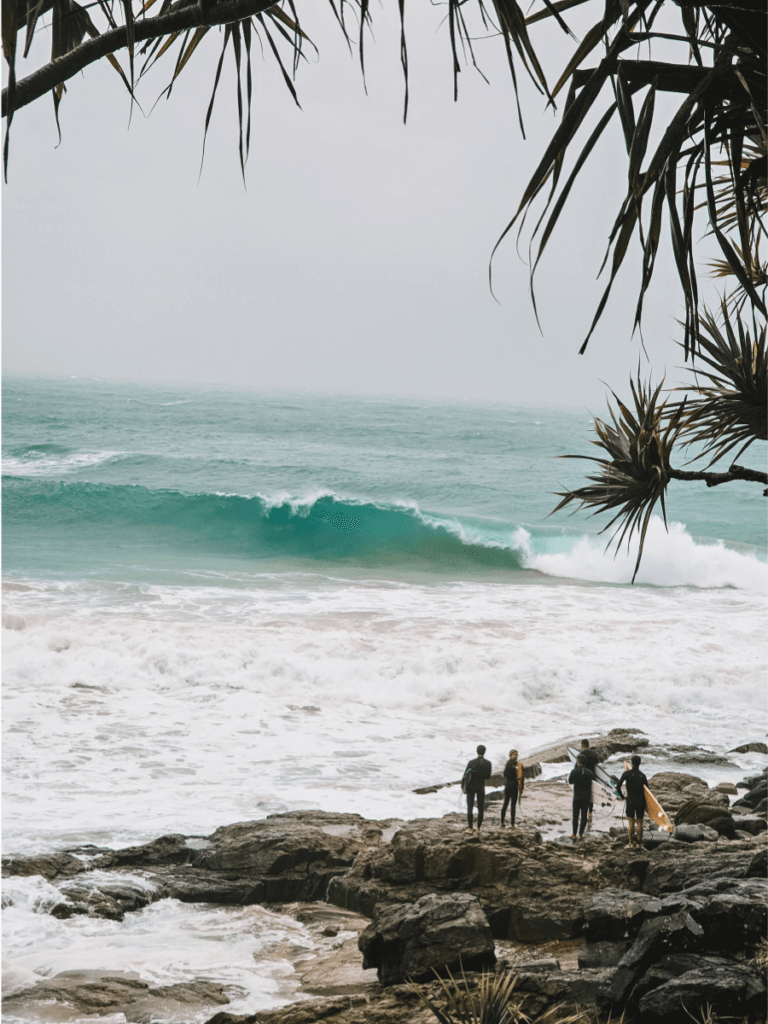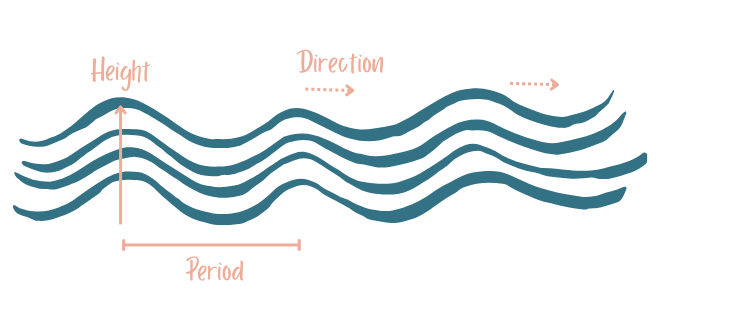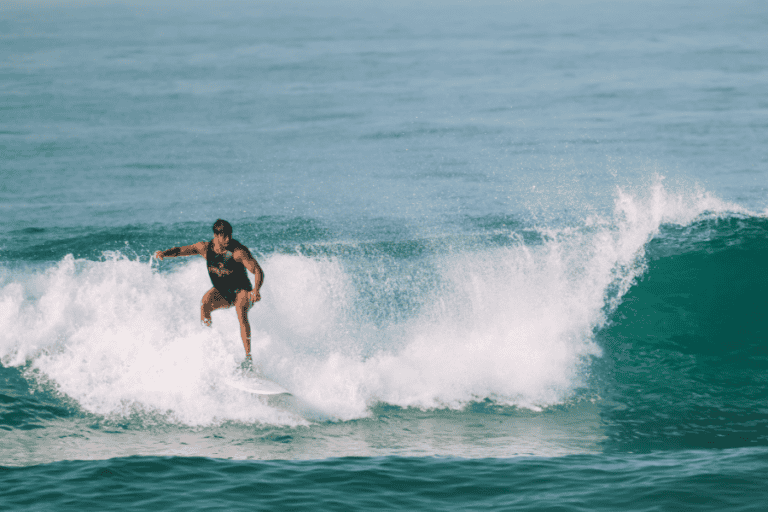What is a Swell – Basics of Reading a Surf Forecast
In this article you will learn the basics about “What is swell?” “How waves are created?” and “Why do they break?” – essential knowledge for every surfer to read a surf forecast.

Have you ever wondered why the waves at your surf spot look different every day? Or why some surf spots are particularly beginner-friendly, while others are better suited for experienced surfers? Maybe you’ve also noticed that so-called beginner spots suddenly feature massive waves or appear completely flat like a lake on some days.
To understand all this – and even predict it using a surf forecast – it’s essential for surfers to know how waves are created and to understand the basics of swell and wave breaking. This knowledge is the foundation for reading a surf forecast correctly and selecting the best surf conditions for your skill level and board preferences (e.g., longboard or shortboard).
Choosing the right surf spot is crucial for your progress and safety in the water. When you understand how swells travel across the ocean and interact with the coastline, you can intentionally pick surf spots that offer different conditions depending on the swell’s direction and size. (Learn here how to read a surf forecast correctly.)
In this article, you will learn the basics of what is a swell and how waves are created.
What ist a Swell?
The waves we surf are mostly generated by wind blowing hundreds of kilometers away over the ocean. This wind arises due to differences in air pressure caused by temperature fluctuations (between high-pressure and low-pressure areas).
To equalize pressure differences, air flows from high-pressure areas to low-pressure areas. These differences occur because the sun heats the Earth’s surface unevenly. The stronger the pressure difference, the stronger the wind. Once the wind reaches a certain strength, it becomes a storm—and for us surfers, these storms are particularly important as they form the basis for generating large swells. You can track such storms on weather maps like Windy or Windfinder.
At this point, it’s crucial not to confuse the local winds you feel at the beach with those involved in swell formation!
Key Factors in Swell Formation
For a storm to create good surfable swells, it should be far from the surf spot. For instance, European surf spots often benefit from storms near Iceland, where high- and low-pressure systems collide, generating strong winds. The following factors are crucial for swell formation:
- Wind Strength: The wind must be strong enough to transfer energy to the water surface.
- Wind Duration: The longer the wind blows, the more energy accumulates in the water.
- Fetch: Fetch refers to the distance and time a wind can blow uninterrupted across a water surface. The longer and farther the wind blows—meaning the greater the fetch—the bigger the waves.
As wind blows over the water, it sets water molecules into motion. These molecules don’t move linearly forward but rather in circular orbits, known as orbital motions. This explains why objects like balls or messages in bottles tend to stay in one spot instead of drifting in a particular direction. In open water, no mass transport occurs; instead, energy is transmitted in circular motions. Neighboring molecules pass this energy along, creating what we call wave motion.

When the wind blows consistently in the same direction over hundreds or even thousands of kilometers (within the fetch), larger and more regular waves, known as swells, form and arrange themselves into groups (Sets).
Why do Waves Break?
These large wave sets travel vast distances across the ocean within a couple of days and can reach the shore without losing much energy. For surfers, it’s ideal if this wave journey remains undisturbed by additional winds, so the waves maintain their structure and arrive cleanly at the coast.

When the wave motions of a swell reach the shallower coastal waters after several days, their energy is slowed by the increasingly shallow seabed. The lower orbital motions lose speed, while the upper ones continue moving until they eventually topple over, causing the wave to break.
Rule of Thumb: A wave breaks at a water depth approximately 1.3 times its height.
- For example: A 1-meter wave breaks at a depth of about 1.3 meters while a 1.5-meter wave breaks at around 1.9 meters depth.
Influence of Wind, Tides, and the Seafloor
Seafloor:
The nature of the seabed plays a significant role in how a wave breaks. A gently sloping seabed creates mellow waves, while a steeply sloping seabed generates powerful, steep waves.
- Gentle Waves: Form at beaches with gradually sloping seabeds (e.g., beach breaks).
- Steep Waves: Develop at locations with abrupt seabed drop-offs, such as reef breaks or steep sandbanks—these areas can even produce barrels.
Tides:
Tides also affect how waves break: At high tide, smaller waves often break close to the shore as shorebreaks, making them difficult or impossible to surf. (Learn everything about how tides affect surfing in this article)
Wind:
Locally impacting wind can additionally influence the quality of waves:
- Offshore Wind: The wind blows from the land towards the waves. This is surfers’ favorite type of wind. It makes the wave steeper and cleaner.
- Onshore Wind: The wind blows from the sea towards the land. This compresses the waves, which can make them bulkier. Depending on the strength of this wind, the conditions can become very messy, making good surfing nearly impossible.
- Cross Shore Wind: The wind blows sideways onto the waves. Strong cross-shore winds can also create challenging conditions. In some cases, one side of the wave may be significantly more affected than the other.
Without winds or storms, and the resulting orbital motions, waves would not exist. These motions transport energy across the ocean until the waves break along the shore. Whether a wave is surfable depends not only on the swell but also significantly on the seafloor, tides, and local wind conditions.
The following short video is my favorite illustration about that topic that summarizes swell and wave mechanics perfectly!
What Are the Characteristics of a Swell?
Summarized, a “swell” is a wave motion created by wind or storms over the ocean. These waves travel in groups, known as sets, until they reach a shallower coast, take shape, and eventually break.
A set typically consists of 2 to 7 waves, with the number of waves per set remaining consistent within a swell. Between sets, there is a lull in wave movement, called the swell pause. The further the swell travels, the longer these pauses become. For surfers, orderly swells with long pauses are ideal because they offer clean waves and enough time to paddle back into the lineup.
Swell vs. Surf: It’s important to understand that a swell is not the same as the waves we observe or surf at the beach. When interpreting a surf forecast, distinguishing between swell and surf is crucial.
A swell is characterized by the following factors:

Swell Height
The swell height is measured in meters (or feet) and represents the wave height from the trough (lowest point) to the crest (highest point). This measurement is taken on the open ocean, often using buoys, before the waves reach the coast.
Swell Period
The swell period indicates the time, in seconds, between two waves. In deeper water, waves with a longer period travel faster than those with a shorter period. As they approach the coast, they slow down abruptly and break with more power.
- A period up to 5 seconds usually indicates weak, disorganized waves created by local winds.
- At around 8 seconds or more, the swell is typically well-formed, clearer, and carries more energy. Surfers often prefer swells with periods of 12 seconds or more, traveling far to surf at prime spots when such conditions are forecasted.
- Periods of 17 seconds or more are rare. Only a few spots can accommodate such swells, and these waves are very powerful—caution is advised, especially for beginners.

For instance, a 0.5-meter swell with an 18-second period can produce 2-meter surfable waves at a suitable spot. Therefore, when reading a surf forecast, the period is often more critical than the swell height.
Longer periods carry more energy because the orbital motions extend to 1.5 times the wavelength or period into the water’s depth. Additionally, the waves move larger volumes of water (length × height), creating more powerful waves as they encounter shallower coastal areas.
Swell Direction
The swell direction is expressed in degrees and indicates the original direction of the waves. It’s measured as the angle between north (0°) and the direction the waves come from. For example, a swell at 45° originates from the northeast.
Primary Swell vs. Secondary Swell
When reading Surf Forecasts it’s important to understand the difference between Primary and Secondary Swell:
- The primary swell represents the wave energy with the greatest potential to reach the coast.
- The secondary swell is the second strongest wave energy.
If both primary and secondary swells arrive at the same spot from the same direction, they can combine to create larger, more powerful waves.
Conclusion
Thanks to surf forecasts, we can access essential data to assess surf conditions without needing to analyze weather charts. However, the more we understand what a swell is and how waves are formed and break, the easier it becomes to interpret these forecasts—and to be in the right place at the right time.
By exploring the theory of wave formation, surfers can develop a deeper understanding of the ocean’s natural rhythms and strengthen their connection to nature. This knowledge allows you to act more intuitively, maximize your surf sessions, and plan your surf trips better.
In this article, you’ve learned the basics of swell and wave formation. (Stay tuned for more insights into tides and other factors affecting your surf adventures!)






